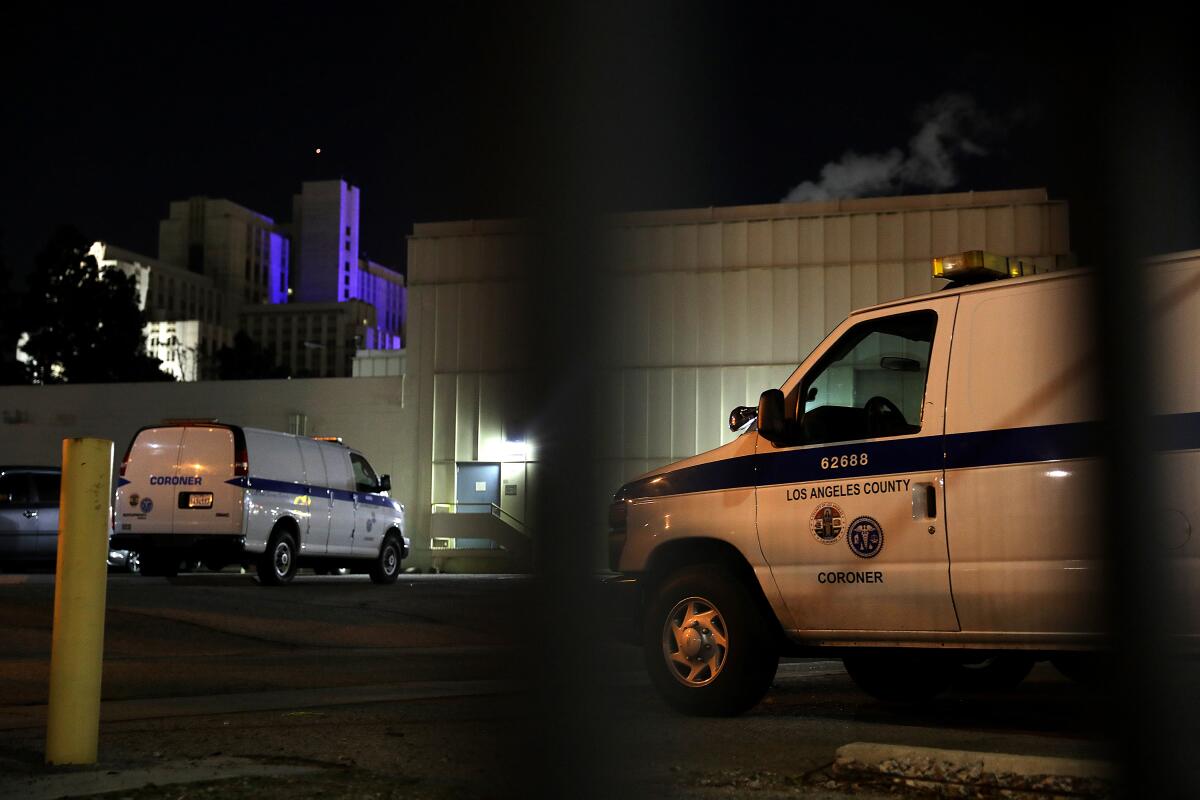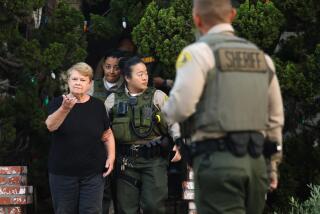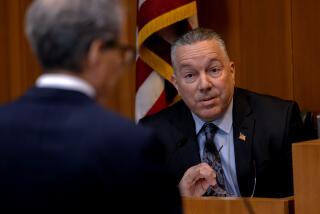Coroner employees say body part donation interfered with death investigations

Despite the Los Angeles County coroner’s insistence that harvesting body parts hasn’t harmed investigations, internal documents show that morgue employees have raised concerns for years about procurements of tissues and organs.
In nearly 60 internal complaints, emails and other documents received from anonymous sources by The Times, more than 20 pathologists, investigators and other coroner employees detailed how procurement had interfered with their work, including in the department’s duty of determining the cause of death.
The documents, dated from 2002 to 2018, surfaced three months after The Times published articles on how companies that procure body parts from the deceased for transplants and use in medical products are operating inside morgues across the country, including in Los Angeles. Reporters found that as a result dozens of death investigations have been compromised or delayed.
The new documents include three autopsy reports where county medical examiners describe losing crucial evidence when OneLegacy, a human tissue procurement company, removed body parts before the coroner’s autopsy. Detectives were investigating two of those deaths at the time the body parts were procured.
In information for the death certificate of an otherwise healthy infant who died in 2010, for example, Deputy Medical Examiner Yulai Wang wrote on the line asking how the injuries had occurred, “Unknown, external factors could not be excluded, limited autopsy due to organ donation.”
Tom Mone, OneLegacy’s chief executive, said late last month he was unaware of “any case” where a county “medical examiner concluded that the cause of death was unable to be determined due to recovery” of organs or tissues.
And Jonathan Lucas, the L.A. County chief medical examiner-coroner, said he believed it was unlikely the organs would have helped explain the infant’s death since they were functioning when they were transplanted into others.
Lucas said the disclosure of the internal complaints by coroner staff did not change his view that organs or tissues could be “routinely” taken before his department’s autopsy, even in the midst of homicide investigations. He said he believed the staff could use other evidence such as X-rays, hospital records, police reports or the victim’s medical history to compensate for not being able to examine some body parts.
To help safeguard evidence, he said this week that he would begin requiring OneLegacy to photograph the body before the removal of any organs or tissues.
“I know how to manage these cases quite well,” Lucas said.
Lucas said he had not received any formal written complaints about OneLegacy since he was hired to oversee the coroner’s department in April 2018. The 60 complaints received by The Times are a small subset of all investigations where procurement took place, he noted.
Last year Lucas had told The Times that in the opinion of him and his staff, no criminal investigation or cause-of-death finding had been impeded by the procurement of body parts before autopsies in the county.
The internal documents reveal that coroner staff members have repeatedly raised concerns about interference.
In October 2008, coroner employees complained in written notes on an autopsy that OneLegacy went over the head of a coroner employee who had denied its request to procure body parts from a homicide victim and gained approval from a department physician who held more authority. The victim “had been shot numerous times in the head and torso,” according to county documents.
Lieutenant Fred Corral of the investigative division wrote that a OneLegacy employee had then called the morgue to report that its surgical team had found a bullet in the victim’s torso. “They were calling to ask what do with the recovered projectile,” Corral wrote.
He said he instructed the person to photograph the place in the body where the bullet was discovered. But the OneLegacy employee told him that was impossible because, Corral wrote, “the decedent had been sewn up.”
Upon learning the company could not document the bullet’s location, Mario Sainz, an investigator, added in the written notes, “This is a good example why we shouldn’t allow harvesting on homicides!!!”
Added Deputy Medical Examiner Pedro Ortiz in the notes, “Now I get the mess that One Legacy did and also I have to take the heat in court. Thanks One Legacy!!!!”
Corral, Sainz, Ortiz and Wang, who performed the infant’s autopsy, did not respond to emailed requests for comment.
Mone, the chief executive of OneLegacy, which is registered as a non-profit, told The Times that his surgical teams had gained proper authorization for the procurements from one of the coroner department’s physicians for each of the deceased who donated tissues or organs. In OneLegacy’s view, Mone added, coroner investigators like Corral “do not have the medical training or legal authority” to restrict what body parts can be procured.
Mone said OneLegacy routinely provides photos, X-rays and information from its exam of the body to the coroner to aid in death investigations.
Reporters made requests in February 2018 using the state’s public records law for all written complaints from coroner staff about organ or tissue procurements. In answer to those requests, officials provided six complaints before The Times published its stories last year.
Recently coroner officials said they had found 16 additional complaints that should have been previously provided to the newspaper.
Years ago the department created a standard internal form for “statements of concern involving organ and tissue donation cases.” Employees wrote dozens of these complaints but Lucas said the department did not formally track them. Lucas said he did not know if they had been investigated to determine whether they were accurate.
The documents that The Times received from other sources included an internal email sent in 2012 by Denise Bertone, a coroner investigator, to Lakshmanan Sathyavagiswaran, who was then the chief medical examiner-coroner, about the autopsy of an infant from Compton. “It is a recurring problem that One Legacy harvests these infants before photographs and X-rays are taken,” she wrote in the email.
Bertone no longer works for the county. Her lawyer said she wasn’t available to comment.
Mone at OneLegacy said there was ultimately no donation in the infant’s case.
In the autopsy of a hit-and-run victim in 2008, Deputy Medical Examiner Louis Pena wrote that he could “not assess the bumper height” of the car since the lower leg bones — shown to be fractured in X-rays — had already been taken. The bumper’s height was critical information in the case because police believed the car may have been a newer model Lexus SUV, according to county reports.
Sathyavagiswaran, then the chief medical examiner-coroner, wrote in an internal email to other county officials and a OneLegacy employee, “I have always advised our staff — No SKIN / BONES ARE TO BE PROCURED ON HOMICIDE/TRAUMA CASES. Can we talk to the DME who approved it,” using shorthand for deputy medical examiner.
Sathyavagiswaran did not return messages. Pena, now a medical examiner in San Francisco, declined to comment.
Lucas told The Times he doesn’t believe examining the bones was essential to the investigation and that he could have estimated the bumper height using the X-rays.
Leg, other bones and patches of skin were also missing from the victim of a 2018 hit-and-run in Canoga Park that police were investigating as a homicide. A witness told a detective that she saw the women standing behind the car, yelling at the driver, when the car suddenly backed up and violently hit her. The driver then continued to back up, driving over the woman, the witness said. The driver, another woman, then got out of the car, looked at the body underneath the vehicle, before getting back in, running over the victim again and speeding off, according to the witness’ account in the police report.
The county physician performing the autopsy detailed in her written report how her exam was constrained by the removal of skin and bones.
“External examination is limited by the organ procurement, which has involved bilateral lower extremities and removal of a large section of skin and soft tissue from the back,” wrote Julie Huss-Bawab, an associate deputy medical examiner.
“No abrasions or lacerations were identified in areas not obscured by organ procurement,” she wrote in her final opinion.
She added that she could not determine whether the death was a homicide because her autopsy findings and other information did “not exclude or confirm the intentions of the vehicle’s driver.”
Lucas, the chief medical examiner-coroner, said this week there was no document in the victim’s file to show that OneLegacy had obtained approval from his department to procure the skin and bones “but we have an indication that (the document) exists.”
He said he believed the manner of death would still have been left “undetermined” because of a lack of information even if the bone and skin had not been procured.
A spokeswoman for the coroner said that Huss-Bawab had reviewed a photo of the body before the bone and skin were removed but “we no longer have access to that image.”

In 2015, Lucas co-wrote an academic article where he detailed why it was crucial to examine leg bones, skin and clothing to gain clues in a hit-and-run death. In recent years, the number of these types of investigations has increased in Los Angeles as the number of pedestrians killed by vehicles soared.
Lucas wrote in the article that “internal examination of the legs of pedestrians is the gold standard when interpreting bumper impact injuries.”
“Partial autopsies,” he wrote, “give partial answers.”
Asked about the article, Lucas said that even though organ or tissue donation will change how the autopsy is performed in a hit-and-run case “that doesn’t mean we lose critical information.”
A California law requires coroners to work with the human tissue procurement companies “to maximize” the number of body parts obtained for transplants. Industry lobbyists helped write that legislation, The Times reported, and then helped pass it in states across the country.
The organs help those waiting for transplants, while the bone, skin and other tissues are used mostly as raw material by biotech companies, which process it into high-priced medical products sold to surgeons.
“This is a necessary relationship for us,” Lucas said. “It’s our responsibility to make sure it doesn’t significantly compromise our cases.”
In response to the Times stories, the L.A. County Board of Supervisors called on Lucas in October to provide a report on the impacts of body part procurements on his investigations. The report is expected as early as next week.
Times staff writer Nicole Santa Cruz contributed to this story.
More to Read
Inside the business of entertainment
The Wide Shot brings you news, analysis and insights on everything from streaming wars to production — and what it all means for the future.
You may occasionally receive promotional content from the Los Angeles Times.









